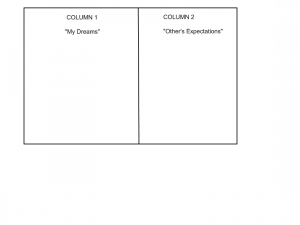What I’m Willing to Live With
The graphic organizer is a thick-lined two column box. In one column,  my students pencil in their own dreams for the future. On the other side, they list what “others” expect of them in the coming years. Then we talk about how these two columns are sometimes in conflict.
my students pencil in their own dreams for the future. On the other side, they list what “others” expect of them in the coming years. Then we talk about how these two columns are sometimes in conflict.
This sets up the excerpt we read from the Joy Luck Club, in which a mother pressures her daughter to become a child prodigy. This is just one of many readings selected for high schoolers that manages to get at me more than it does my students.
In my head, if I’m honest, as much as I pride myself on being passionate and driven, I still weigh columns like this more than I care to admit.
In the first column, there are the causes and projects that burn white hot inside me–the things that insist on being brought to expression.
In the second column, I reflect on the expectations of others–mainly the “others” of Christianity. Despite my tensions with parts of it, this is the only subculture where I’d be considered a native (unless you count “skinny white girls” as a subculture). I don’t have to physically write anything out to know this column is packed—crammed with the opinions of parents, leaders that I respect, books I’ve read, conventional religious opinion, social norms, peer approval.
Both columns–like for the characters in the story; like for my students–hold weight inside me of course. The first column, the pursuit of the divine-in-me, holds this adrenaline-lit and sometimes risky path to the unknown. The second column, the affirmation of peers, can also be a welcome, tangible comfort while living on a dysfunctional planet where God doesn’t always seem as “right here” as I wish he was.
The prospect of conflict between the two columns–investing in one at the expense of the other–is uncomfortable. Pulling away from either column would be scary.
But one scares me A LOT more than the other.
The older I get, the more I know what I am willing to live with and what I am not willing to live with.
I am willing to live without the affirmation of my peers if needed, for example (although, let’s be honest, it’s not my preference). However, I am NOT willing to live in an eternally-curious state, wondering what my life could’ve held had I learned to live “all in” in Column 1.
Complexity #4,569: to translate that into my life.
Any ideas?


Katrina September 8, 2010 (9:41 pm)
Wow! What a great idea! Really makes you think, huh? I’m going to have to make that list for myself…I should also use it in the junior high girls Sunday School class that I teach. Thanks for the idea! :) As far as your question on how to translate that into your life, that’s the hard part! :) Maybe start by making another list…a list of the things you do and spend time and energy on in your everyday life and divide them up in those two categories. Then you could see how the different motivations are practically playing out in your life and that can help you make changes. :)